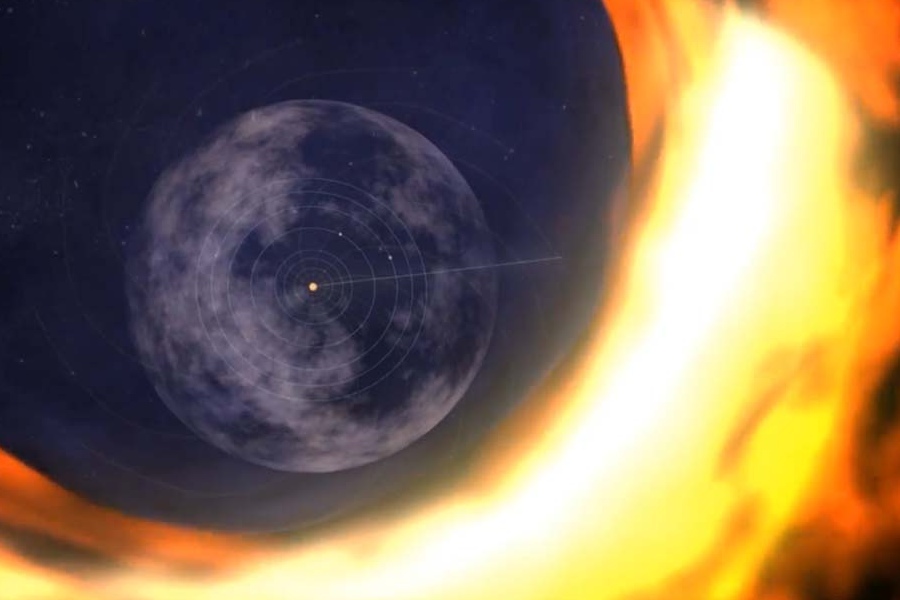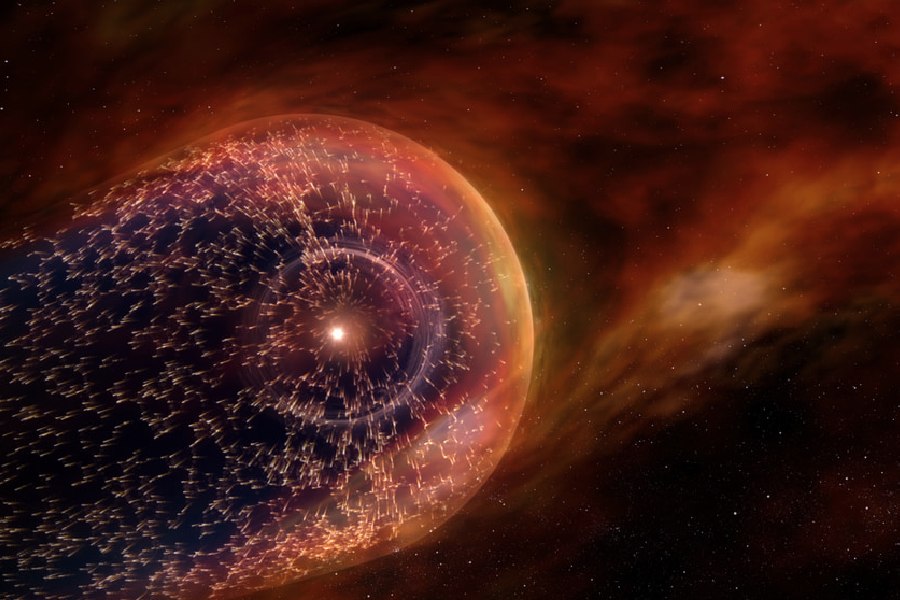Fierce ions race outwards as the solar wind streams from our Sun’s turbulent surface until their journey ends at a distant boundary. This distant edge of our star’s sphere of influence into the interstellar depths is of great interest to astronomers. At this distant frontier lies a vast, shimmering bubble – our heliosphere. But what is heliosphere?
Untangling the mysteries around what allows Earth’s star to carve out an island of dominance within surrounding interstellar space represents one of our focuses. This also raises questions about the origins and nature of our stellar neighborhood.
In this article, we will unravel the heliosphere definition and the mysteries around the heliosphere’s anatomy; from investigating contained layers like the termination shock to bravely tracing the journey of solar wind ions.
We will also explore how solar wind particles eventually pile up and accumulate. This buildup shapes the outermost edges of our Sun’s influence over hundreds of astronomical units. So, let’s start and discover heliosphere facts!
What Is Heliosphere?
The heliosphere is a vast space around the Sun whose influence extends through the solar wind. It is a protective bubble that shields the solar system from cosmic rays. Also, the heliopause’s outer boundary marks the transition to the interstellar medium.
Delving into the heliosphere enhances our comprehension of dynamic interactions between the Sun and the broader galactic environment. Insights from spacecraft like Voyager, as they venture into the solar system’s outer reaches, contribute valuable knowledge.

The Sun’s Domain: Solar Wind and Solar Atmosphere
Solar wind basics
The solar wind is a continuous stream of charged particles from the Sun, primarily protons and electrons. This relentless outflow, driven by the Sun’s intense heat and magnetic activity, extends far into the reaches of the solar system.
This dynamic flow of particles plays a crucial role in shaping the heliosphere, the Sun’s extended influence throughout space. As the solar wind travels outward, it carries with it the Sun’s magnetic field, creating a protective bubble that envelops the entire solar system.
Layers of the solar atmosphere
Delving into the layers of the solar atmosphere provides a glimpse into the complex dynamics shaping the heliosphere. The Sun’s atmosphere has several layers, including the photosphere, chromosphere, and corona.
The photosphere, the Sun’s visible surface, is where most of the Sun’s energy is emitted. Above it, the chromosphere and corona extend into the Sun’s outer atmosphere.
The interactions and processes within these layers contribute to the generation of the solar wind, influencing the structure and behavior of the heliosphere. So, understanding these layers is crucial in unraveling the mechanisms that govern the Sun’s influence on the wider cosmos.
Characteristics of the Heliosphere
The heliosphere is a vast region influenced by the Sun’s dynamic interactions with the interstellar medium. It exhibits key characteristics that define its nature and role in our cosmic neighborhood.
Solar wind speed
One fundamental characteristic is the speed of the solar wind, the continuous stream of charged particles ejected by the Sun. The solar wind speed varies with the Sun’s activity, typically ranging from 300 to 700 kilometers (186 to 434 miles) per second.
This high-speed outflow creates a constant outward pressure. So, it shapes the heliosphere and influences the dynamics of the surrounding space.
Magnetic field strength
The heliosphere is accompanied by the Sun’s magnetic field, extending far into space and affecting the trajectories of charged particles within the solar wind. The strength of this magnetic field is a crucial characteristic, influencing the heliosphere’s structure and interactions.
The solar wind travels outward, stretching magnetic field lines to form a protective shield around the solar system. This shield safeguards it from the majority of cosmic rays and interstellar particles.
Neutral atom population
In addition to charged particles, the heliosphere contains a population of neutral atoms originating from the interstellar medium. These neutral atoms penetrate the heliosphere and can be detected by spacecraft.
Understanding the characteristics of this neutral atom population provides insights into the heliosphere’s interface with the surrounding interstellar environment. This, in turn, enhances our understanding of the region’s boundaries and intricate interactions.
Synthesis of key characteristics
Synthesizing these characteristics paints a comprehensive picture of the heliosphere’s dynamic nature. It is a vast and complex region, shaped by the solar wind’s speed, the strength of the Sun’s magnetic field, and the interplay with neutral atoms from the interstellar medium.
Understanding the heliosphere’s important role involves synthesizing its components. This protective barrier shields our solar system, dynamically interacting with the vast galactic environment.
Hence, the ongoing study of these key characteristics deepens our understanding of the heliosphere’s intricate mechanisms and its significance in the grand tapestry of our cosmic surroundings.

The Structure of the Heliosphere
Besides knowing “What is heliosphere?” we should explore its structure. The heliosphere, shaped by the Sun’s influence, is a dynamic and expansive region. It is structurally delineated into distinct inner and outer regions, each playing a unique role in the solar system’s interactions with the wider cosmos.
Inner region
The inner region of the heliosphere is marked by the influence of the solar wind and the Sun’s magnetic field. This region extends from the Sun to the termination shock, where the solar wind abruptly slows as it encounters the pressure of the interstellar medium.
The solar wind takes control within the inner boundary, shaping the heliospheric environment. It influences the behavior of charged particles, defining their dynamics in this cosmic space.
Outer region
Beyond the termination shock lies the outer region of the heliosphere. Here, the solar wind interacts with the interstellar medium, creating a boundary known as the heliopause. The heliopause transitions from the Sun’s influence to the interstellar environment.
Beyond this boundary, the heliosphere’s effects diminish, giving way to interstellar space’s vast and unexplored reaches. Though less influenced by the solar wind, the Sun’s magnetic field continues to shape the outer region.
Exploration of the Heliosphere
Unlocking the mysteries of the heliosphere requires a blend of space probe missions and observations from Earth-based instruments. This dynamic approach enables scientists to collect invaluable data, unraveling the complexities of this intriguing cosmic realm.
Space probe missions
Numerous space probe missions have been instrumental in exploring the heliosphere. The Voyager spacecraft, launched in the late 1970s, provided groundbreaking insights into the outer reaches of the solar system. Voyager 1 and 2 crossed the termination shock and entered the outer heliosphere, transmitting valuable data about its structure and dynamics.
Launched in 2018, the Parker Solar Probe is on a mission to explore the Sun’s outer atmosphere. It aims to understand the processes shaping the solar wind, thus contributing to our broader comprehension of the heliosphere.
Observations from Earth
Observations from Earth-based instruments, such as telescopes and detectors, complement space missions in heliospheric research. Ground-based observatories monitoring solar activity and its effects on the heliosphere provide continuous data.
Earth-based instruments also play a role in studying the interaction between the solar wind and the Earth’s magnetosphere. They contribute to understanding the heliosphere’s influence on our home planet.
Conclusion
What is heliosphere? By tracing the solar winds to the fringes of our sun’s sphere of influence, we now appreciate the structure and form of the heliosphere bubble that protects our solar neighborhood.
By examining key traits like its protective magnetic barrier and streams of particles, we have shed light on the heliosphere and how it shields planets like Earth. We hope learning about our solar system’s boundary with surrounding interstellar space has brought interest in what other star systems’ edges might resemble.
Potential discoveries await as future probes trace the solar wind’s path toward the outer reaches. These revelations could unveil insights into how our Sun creates a protective enclave for life amidst the galaxy’s vastness.
